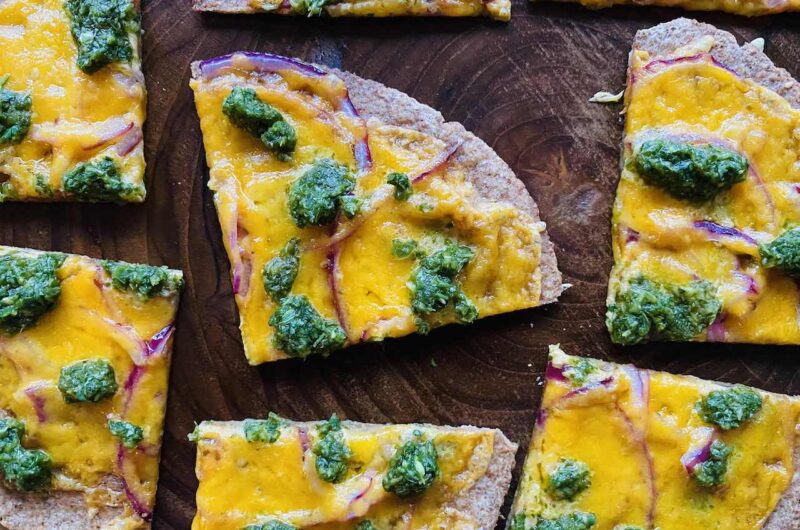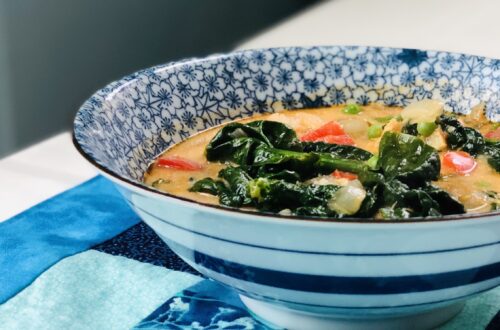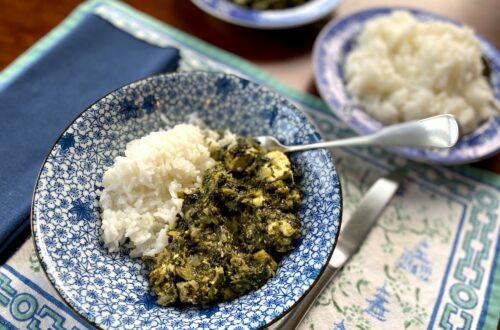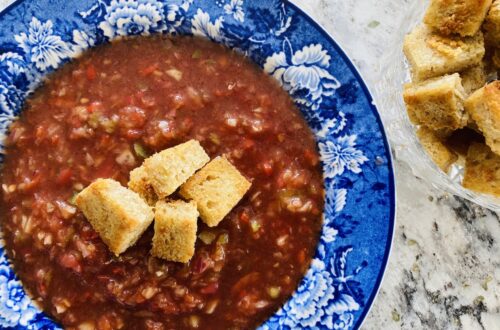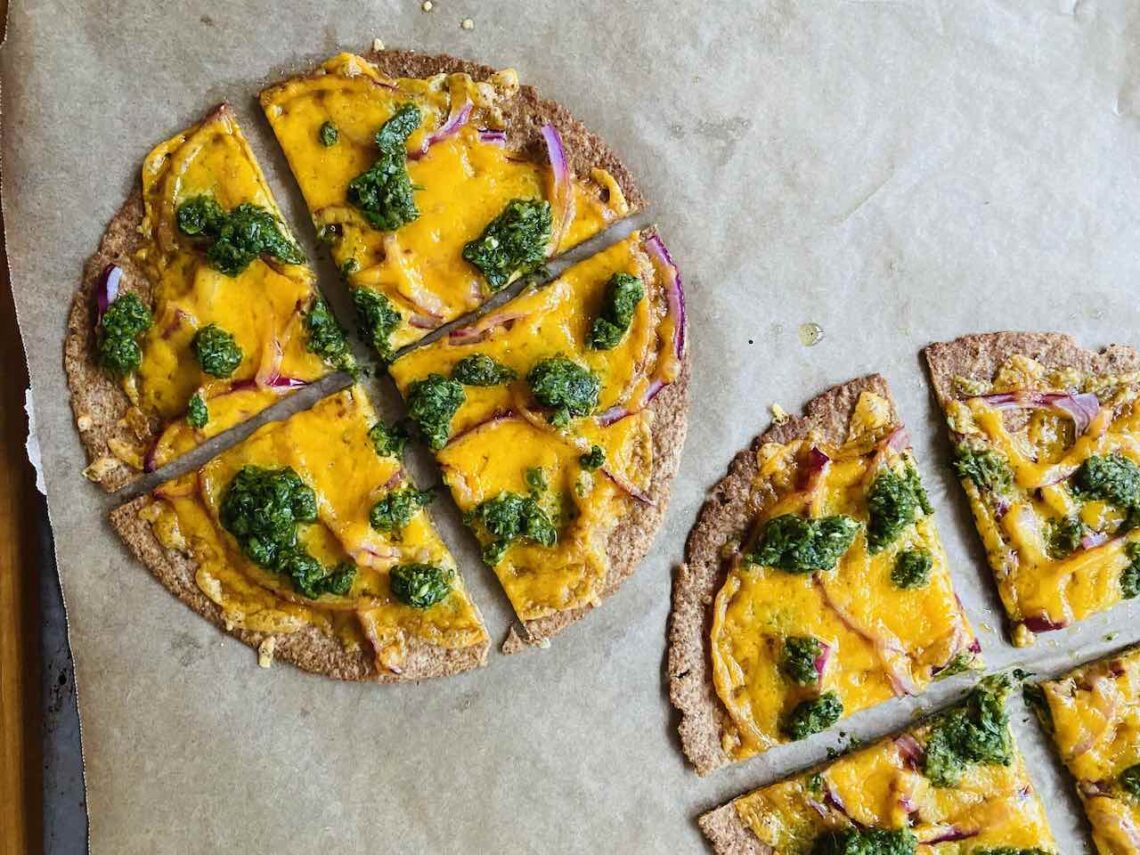
Roti Pizza (aka Whole Wheat Tortilla Pizza with Cheddar and Cilantro Chutney)
Every once in a while I come across a recipe that feels as familiar as if I’ve been eating it my whole life. These roti pizzas (which I usually make on whole wheat tortillas) from Priya Krishna’s cookbook Indian-ish, combine the types of food I loved as a teenager, a mixture of grilled cheese sandwiches and Indian food from Rajun Cajun, the best (and only) Indian takeout spot in Hyde Park. These pizzas – with the brightness of red onion, the saltiness of sharp cheddar cheese, and the tang and spice of cilantro chutney – bring together my favorite childhood flavors in a weekday work-from-home lunch (or dinner or snack).
One underrated ingredient in this – and most – recipes is salt. Salt is fascinating, such a minor but important ingredient in all food. It is key to everything we eat, yet we rarely think about it. It not only gives food its own salty flavor, but it also brings out the flavor in other ingredients. James Beard once asked: “Where would we be without salt?” To which Samin Nosrat answered: “Adrift in a sea of blandness.”
There are so many types of salt, and recipes often call for slightly different kinds – sea salt, kosher salt, iodized salt, non-iodized salt. (Just to make things more confusing, recipes often call for kosher salt because it is pure – that’s why it’s used for koshering meat. But in the US, there are two main brands of kosher salt: Diamond Crystal and Morton’s Salt. Morton’s is twice as salty as Diamond Crystal, so be careful which you use.) Moreover, some salts are iodized while others are not. Naturally occurring salt contains iodine, but that iodine is removed when salt is processed for consumption. In the US, salt producers used to add the iodine back later in the process because people didn’t eat enough iodine in other foods and had a variety of health issues as a result. We now get enough iodine from other sources, allowing various types of non-iodized salt to proliferate.
You may have heard of these different types of salt, but what is salt? The salt we eat on food is the compound sodium chloride. (Other compounds are used to salt roads or to salt meats.) While salt may contain small bits of other ingredients, sodium chloride is what makes it salt. All salt comes from seawater and is found in two places: in the oceans or in salt mines (deposits left behind by evaporated seawater).
Table salt often comes from “solution mining,” a process in which a big well is dug into an underground salt deposit. Water is pumped in to dissolve the salt, and the resulting brine is pumped out. The brine is sent to a processing facility, where it is turned back into salt in an energy-intensive process called vacuum pan refining.
Alternatively, salt can be “made” by pumping salt water into ponds and letting it evaporate over a few years. This requires less energy for production, but whether it is an environmentally-friendly method of production is debated. Some believe that certain animals can use these salt ponds as sanctuaries, while others argue that such ponds harm current ecosystems and animals that already live nearby. Moreover, once the sea water is gone, a liquid known as bitterns remains, which can be harmful to fish and marine organisms in large and concentrated amounts.
Despite the amount of energy needed to produce salt and the possible environmental issues, salt seems to fall on the “less bad” end of the spectrum of ingredient ethics – which for this blog is a big win. And it doesn’t seem like one type of salt is better or worse than others. For example, fancy sea salt might require fewer fossil fuels for production, but then it is often packaged in glass and plastic and travels long distances. Meanwhile, Morton’s Salt may be highly mechanized, but the salt doesn’t travel as far to be packaged and sold. The same is true for Diamond Crystal, which many cooks swear by – but which is owned by Cargill, the same company sued for using forced labor in its cocoa supply chain. That’s not to say you shouldn’t buy salt – please keep cooking with salt and enjoying your food! It’s just to point out that in the modern world these are always complex calculations without straightforward or simple answers.
To learn more, consider reading a whole book on salt(!), titled Salt: A World History, by Mark Kurlansky. And if you’d like to learn more about how to use salt in cooking, check out Samin Nosrat’s amazing cookbook, Salt, Fat, Acid, Heat, or watch her Netflix show of the same name.
Roti Pizza (aka Whole Wheat Tortilla Pizza with Cheddar and Cilantro Chutney)
Course: Uncategorized2
servings15
minutesNote that this recipe is only for two servings. You can certainly scale it up for more people.
Ingredients
- Pizza
Four whole wheat tortillas or roti (about 7 inches in diameter)
Olive oil
1/2 red onion, thinly sliced
1 cup (4 ounces) shredded sharp cheddar cheese
- Chutney
1 bunch of fresh cilantro (about 4 cups)
1 small serrano chili, roughly chopped
2 tablespoons fresh lime juice (from about 1 juicy lime)
1/4 teaspoons granulated sugar
1/4 teaspoons kosher salt
Directions
- Make the cilantro chutney. Using a food processor or blender, add the cilantro, serrano, lime juice, sugar, and salt and blend until it becomes a liquid.
- Preheat the oven to 400˚F. Place the whole wheat tortilla (or roti) on a baking sheet and brush with olive oil. Add a liberal sprinkling of sliced onions to each tortilla, then spread the cheese evenly on the four tortillas. Bake for 4-6 minutes, until the cheese is melted and bubbling.
- Remove from the oven and drizzle each pizza with about two tablespoons of the cilantro chutney. Cut into pieces and enjoy hot.

